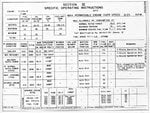Demetrious
Airman 1st Class
- 104
- Aug 22, 2007
Recently I've had reason to look into the gritty mechanical details of high-displacement aero engines in general and the Allison V-1710 in particular. All sources broadly agree that the V-1710 (excluding a few late-war models) generated its maximum power around 3,000 RPM, that it utilized a 0.5:1 reduction gear at the front of the engine (i.e. power to the propeller shaft). This would imply to me that the Allison's max RPMs at the crankshaft were actually 6,000 RPM; since after being reduced by half, the output was around 3000 RPM maximum. This makes perfect sense, since the rough maximum speed of an average-sized propeller is 3,000 RPM (much more than that and the tips exceed supersonic speed, causing all sorts of nasty things.) A few glances at WWIIaircraftperformance.net show max-speed trials for the P-40 with propeller RPM specified as 3,000 for the benchmark tests, so that seems to jell.
However, I've been unable to find a single good source that actually verifies that crankshaft RPMs were that fast; and some discussions google found on these very boards have consistently referred to the crankshaft speeds as being in the 3000 RPM range. I've read of at least one person who installed an Allison in a (stretched) classic car and actually reversed the reduction gear to kick the RPMs up to something suitable for automotive use. The difference between 6,000 and 12,000 RPM is rather drastic; which makes the question of actual crankshaft speed rather important, as I'm trying to answer a question relating to automotive uses of a V-1710.
Please, dispel my confusion!
However, I've been unable to find a single good source that actually verifies that crankshaft RPMs were that fast; and some discussions google found on these very boards have consistently referred to the crankshaft speeds as being in the 3000 RPM range. I've read of at least one person who installed an Allison in a (stretched) classic car and actually reversed the reduction gear to kick the RPMs up to something suitable for automotive use. The difference between 6,000 and 12,000 RPM is rather drastic; which makes the question of actual crankshaft speed rather important, as I'm trying to answer a question relating to automotive uses of a V-1710.
Please, dispel my confusion!

